In this issue:
Spotted Wing Drosophila
Hornworms
Garlic Problems
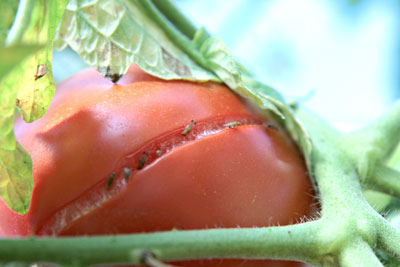 |
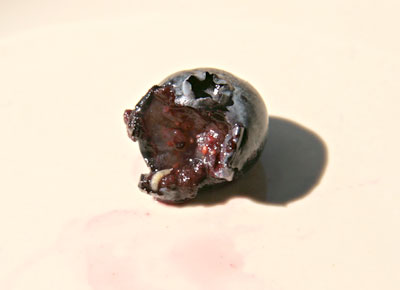 |
| Spotted wing drosophila on a tomato | Drosophila maggot in a berry |
Spotted wing drosophila is here and the larvae are in small fruit now.
The spotted wing Drosophila, as most of you know by now, is a species of fruit fly that, unlike the typical fruit fly found around overripe fruit, can pierce the skin of just ripe fruit and lay an egg. Most of you also know by now that the egg hatches and the larvae consume the fruit from the inside out. Watch out for soft fruit.
The fly is easy to recognize. It looks like a regular fruit fly, but there are spots on the wings.
Management is all about harvesting and post harvest handling. Pick the fruit often and do not allow ripe fruit to hang around. After picking, refrigerate or freeze quickly. Do not leave baskets of fruit at room temperature, unless you want to raise maggots.
Spinosad (Entrust or Monterey Garden Spray) is actually very effective, however not practical nor, in most situations, legal. The problem is that the fruit fly has a very quick and large ability to reproduce. The populations become very large by late summer. Spraying would have to happen every 3-5 days to be really effective, and there is a label limit of only 3 sprays per crop. So, management for organic growers is all about harvesting and post harvest handling.
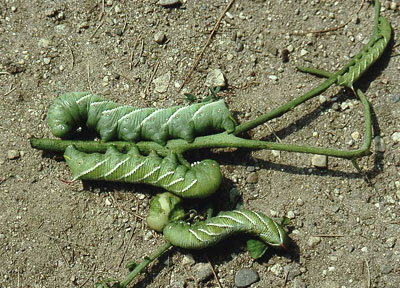 |
| Tomato hornworms. |
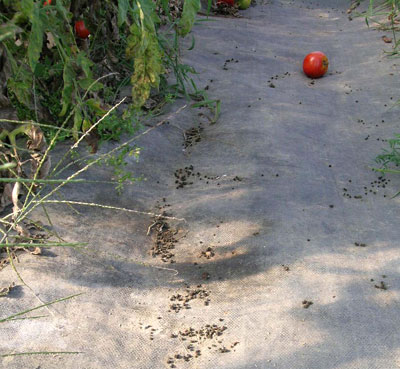 |
| Tomato hornworm frass below tomato plants. |
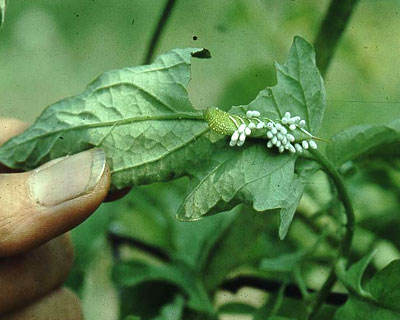 |
| Tomato hornworm hosting braconid wasp cocoons. Vern Grubinger photo. |
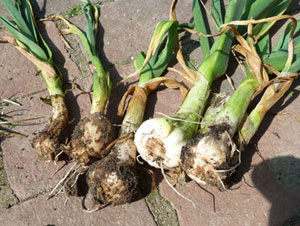 |
| Damage caused by the garlic bulb nematode |
Hornworms are probably the most destructive insect attacking tomatoes and they are showing up now. They are giant caterpillars that can do a vast amount of eating in a very short time. Right now we are finding young, tiny ones. Sometimes it seems that overnight healthy looking tomato or pepper plants are stripped of their leaves leaving bare stems. The hornworms will also attack the fruit eating gouges out so large that they look more like bites of a furry animal than an insect.
Look now for the damage and the frass, which is black pellets laying all around plants hosting hornworms. The frass may be your first sign there is a problem. The frass of young hornworms is small. I don’t bother looking for the caterpillar because they blend in so well, I just look for the frass.
The adults are large, fast flying hawk moths, which in flight may look like a hummingbird. At dusk they hover over flowers sucking nectar. Eggs are laid on tomato leaves and hatch in 5 days.
Hand picking is a bit frightening but does work and chickens enjoy fighting with the challenging pest. The problem with hand picking is that they blend in very well and it is easy to overlook one or two caterpillars, which can do significant damage in a day or two. I got a report from a grower who is using a black light at night and finding the worm shining.
Bt works very well on this caterpillar.
WHAT ARE THOSE WHITE THINGS ON TOMATO HORNWORMS?
Tomato hornworm larvae are parasitized by a number of insects. One of the most common is a small braconid wasp, Cotesia congregatus. Larvae that hatch from wasp eggs laid on the hornworm feed on the inside of the hornworm until the wasp is ready to pupate. The cocoons appear as many small white projections protruding from the hornworm’s body. Parasitized hornworms should be left in the field to conserve the beneficial parasitoids. The wasps will kill the hornworms when they emerge from the cocoons, and will seek out other hornworms to parasitize.
It is time to harvest garlic, and it is time to identify any problems you may have. There are more and more problems with garlic becoming more and more common. Some of these are only transmitted by planting diseased cloves or moving contaminated soil. Here is a bit about some of the common problems to watch out now that you are harvesting, and for when buying and planting garlic seed this fall.
GARLIC BULB NEMATODE (Ditylenchus dipsaci)
The stem and bulb nematode, also called the garlic bloat nematode, is a relatively new garlic pest in the Northeast, first appearing in New York in 2010 and now being found throughout the Northeast. It has been spread by infested garlic seed. I am already getting reports of growers finding it in their plantings this year. The microscopic worms feed by piercing root and leaf cells with their stylet. Leaves of severely infected plants turn yellow and dry prematurely. Plants may be stunted. The roots may be missing and the basal plate may appear to have a dry rot similar to Fusarium basal plate rot.
The pest is favored by wet, cool conditions. Although the pest is not active in hot dry weather, such weather may exacerbate symptoms. The nematode survives freezing and hot weather in soil and plant debris. It can only move short distances on its own. It is primarily moved by growers either moving soil (on tools, boots, etc.), in moving water, in debris from garlic or onion, or most commonly in garlic bulbs used for seed.
Cultural Control
The best way to avoid garlic bulb nematode is to use your own garlic for seed, IF it is not yet infested. Monitor for symptoms of infestation during the growing season and submit suspect plants to a diagnostic lab for confirmation. Contact me or Caleb to get instructions on how to take and where to send the sample.
If it is determined that you do have the problem, DO NOT use your own garlic for seed. Even bulbs that show no symptoms may have low levels of infestation. Obviously, do not sell any garlic for seed from a potentially infested lot. Do not replant garlic in an infested field for at least four years. Other hosts include all Alliums, celery, parsley, and salsify. Mustards, sorghum-sudan grass, and other bio-fumigant cover crops planted during the rotation period have been shown to reduce nematode populations in a field. These nematodes can survive in dry debris so carefully clean equipment and storage areas.
There are no materials that offer control.
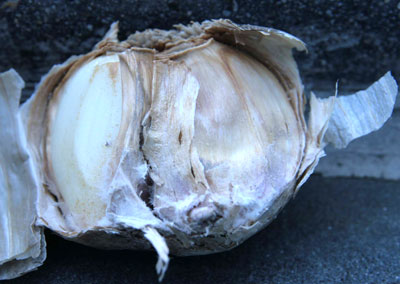 |
| Fusarium rot on garlic |
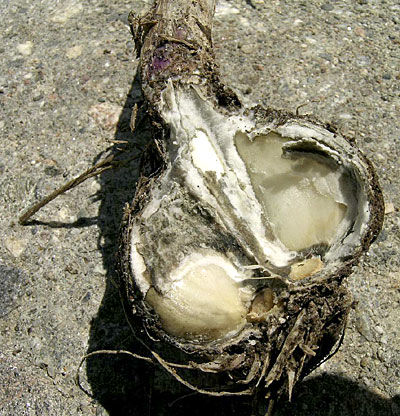 |
| White rot of garlic |
FUSARIUM ROT ON GARLIC (Fusarium oxysporum f. sp. cepae)
Fusarium rot superficially looks like bloat nematode damage. The pathogen invades the basal plate and the roots decay and die. If the infection took place late in the season, then you may not see symptoms until the garlic is in storage.
Fusarium is a fungus that persists in soils as resting spores. Warm, moist soil favors development of the disease. Under very moist conditions a pinkish-white mycelium may develop making the symptoms a bit like white rot. If you are unsure whether your problem is the bloat nematode, white rot, or fusarium rot then you should send a sample into the Pest Management Office for identification.
If you have a fusarium problem, then a three year rotation to crops other than any Allium is recommended.
Garlic should be stored in a cool (32-36 degrees F.), dry place in order to slow the development of the disease.
See MOFGA fact sheet #15: Storing Garden Vegetables
WHITE ROT OF GARLIC (Sclerotium cepivorum)
White rot is a very serious problem because it may spread fast, and once in a field it can persist for many years. Luckily it is a spotty disease and at this time is only present in a small number of fields around the northeast. Those farms can no longer grow any Allium crops in the infested fields.
White rot is one of the most destructive fungal diseases affecting the onion family. It is only a problem on crops in the onion family. (It is not the same pathogen as white mold, which attacks many other crops such as beans, carrots, lettuce, tomato, peppers and more.)
Symptoms of white rot on the leaves include premature yellowing and dying of the older leaves and then death of the plant. That is not much different than many other garlic problems so is not a very useful diagnostic symptom, but the white, fluffy fungal growth (mycelia) on the root end of the bulb is the give away. Eventually this fungal growth moves around the bulb and inward between the storage leaves of onion and cloves of garlic. Small, black sclerotia (tiny hard, black bodies of dormant mycelia) form in the decaying tissue and throughout the white fluffy mycelia. Secondary infections by other fungi may occur.
The pathogen is not known to produce spores. This fungus reproduces only by the sclerotia, and it also spreads by direct contact, i.e., when the mycelium growing on one plant reaches the roots of the neighbor plant in the row. The sclerotia can lie dormant in the soil for many years until roots of a host plant grows nearby and the sclerotia are stimulated to germinate (see below). Dragging the pathogen around on boots, tillage or other equipment, or moving with soil in heavy rains are other ways the disease spreads. Also, animals feeding on diseased bulbs can defecate viable sclerotia.
The best control is good sanitation. Use clean seed cloves for garlic and clean onion sets and transplants. If only a small number of plants are infected, which is usually the case the first year it is found on a farm, pull the infected plants and destroy before sclerotia are formed.
An interesting idea for speeding up the eradication of white rot sclerotia from the soil is to stimulate them to germinate but not have a crop of Alliums for them. Sclerotia will sit waiting in the soil for 20 or more years until a signal is received that onions or garlic are growing nearby. The growing Allium releases a chemical that the sclerotia can sense. Over the past decade researchers have been studying methods that stimulate the sclerotia to germinate but, of course, with no Allium crop growing for the pathogen to complete its life cycle. This “biostimulation” reduces the number of sclerotia in the soil. There is not a specific recommendation yet, but a few things that may reduce sclerotia in the soil include:
- growing scallions which stimulate the sclerotia to germinate, but the scallions are harvested before the disease completes its life cycle
- making compost out of onion or garlic waste and spreading that in the spring or fall repeated for a bunch of years before trying to grow an Allium again
- making a sprayable concoction from ground up onion or garlic waste, or using garlic powder as a soil amendment for a few years before trying to go back to an Allium
If the disease is known to be present, or if onions from other farms are being stored and packed, equipment, storage bins, etc. should be thoroughly pressure-washed and then disinfested for ten minutes with a 0.5% solution of sodium or calcium hypochlorite, (for example, 1:10 dilution of a household bleach). Then rinse with potable water.
Seed producers should execute extra diligence and may want to regularly disinfect any surface in contact with garlic.
Since chlorine materials will be inactivated by organic matter stuck on boots, quaternary ammonium compounds may be used as boot dips inside storage areas and packing sheds, and before and after leaving fields. Quaternary should not be used on any apparatus that is in direct contact with the garlic or onions or any other crop. Disposal of the dip solution must be in a manner that does not contaminate the soil, water or crop. Note: not all quaternary ammonium products are labeled for boot washes so read the label.
At this time, no material has shown efficacy.
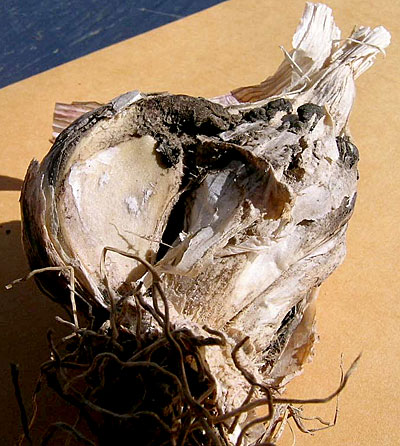 |
| Botrytis porri on garlic. Sideman photo. |
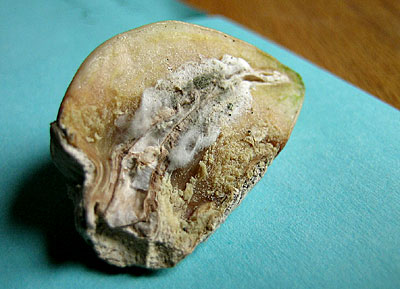 |
| Penicillium decay on garlic. Sideman photo. |
BOTRYTIS ROT
Botrytis rot of garlic is caused by the species, Botrytis porri, which is a different species of the very common genus that includes the speices Botrytis cinerea that causes gray mold. It is not common but sometimes does incite severe disease and may cause major crop loss.
In the field, garlic plants infected with Botrytis rot are stunted and have dead or dying outer leaves. Since most garlic diseases have similar symptoms, it is important to send a sample to the University of Maine Pest Management Office for a positive ID.
Infection develops at soil level and initially looks water soaked but later becomes dry and brown. If conditions are not favorable for the fungus, plants infected with Botrytis porri sometimes recover. If conditions are favorable for fungal growth, and in plants infected later in the season, distinctively large (up to 2 cm) black sclerotia form around the rotting neck of the garlic. At this point the disease is clearly identifiable. Sclerotia are hardened bits of fungal mycelia that are very resistant to environmental stresses of wet, cold, dry and hot. In other words, sclerotia are tough and can survive almost anything in nature. The sclerotia overwinter, and in spring they produce spores that start the cycle again.
Under cool, wet conditions, the disease can become epidemic in a field. It does not progress when the weather is warm and dry; in such conditions, proper irrigation is important in preventing the disease from spreading, so don’t keep fields excessively wet. Good air flow is important, so avoid weedy fields and don’t crowd plants. Excessive nitrogen may also be implicated in susceptibility. Clean seed and crop rotation also help prevent Botrytis rot.
PENICILLIUM DECAY
Penicillium decay may be responsible for poor plant stands in the field but is better known for causing garlic to decay in storage. It is one of the most common storage problems and arises when the harvested garlic does not dry quickly and well. The common name, blue mold, describes the most obvious symptom: The fungus frequently produces a mass of blue spores on the surface of decaying cloves. Spores are not always produced; sometimes, especially early in its growth and under drier conditions, you will see only white mycelia (a mass of fungal filaments) growing on the surface of cloves. Frequently, pencillium rot affects only a few cloves in a head. I have gotten suspicious heads of garlic to sporulate by placing them in a plastic bag for a few days; when the blue spores form, I know the disease is present. Symptoms in the field include wilted or stunted seedlings due to decay. The fungus can spread into the stem plate of young plants, affect the development of roots and result in weak, yellow leaves.
The pathogen is usually Penicillium hirsutum. Inoculum survives from year to year in infected cloves. It does not survive well in soil, so clean seed and crop rotation together very effectively minimize the problem. Even within a single head, some cloves may be infected while others are clean – but when you break heads apart to plant the seed, Penicillium spores are inevitably spread to other cloves, and infection occurs through small wounds. To minimize spreading the problem when you see a few infected cloves, handle the seed carefully to minimize wounding, and plant the seed as soon as possible after separating the cloves from the bulb.

